- Home
- slideshows
- miscellaneous
- The powerful winning images from this year's World Press Photo Awards
The powerful winning images from this year's World Press Photo Awards
Winner: World Press Photo Of The Year

Contemporary Issues - First Prize, Singles
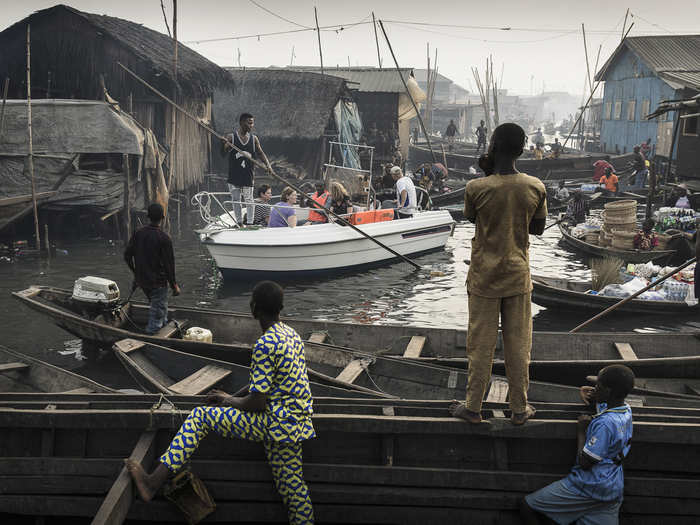
A boat with tourists from Lagos Marina is steered through the canals of the Makoko community — an ancient fishing village that has grown into an enormous informal settlement — on the shores of Lagos Lagoon, Lagos, Nigeria.
Makoko has a population of around 150,000 people, many of whose families have been there for generations. But Lagos is growing rapidly, and ground to build on is in high demand. Prime real estate along the lagoon waterfront is scarce, and there are moves to demolish communities such as Makoko and build apartment blocks: accommodation for the wealthy. Because the government considers the communities to be informal settlements, people may be evicted without provision of more housing. Displacement from the waterfront also deprives them of their livelihoods. The government denies that the settlements have been inhabited for generations and has given various reasons for evictions, including saying that the communities are hideouts for criminals. Court rulings against the government in 2017 declared the evictions unconstitutional and that residents should be compensated and rehoused, but the issue remains unresolved.
Contemporary Issues - Second Prize, Singles
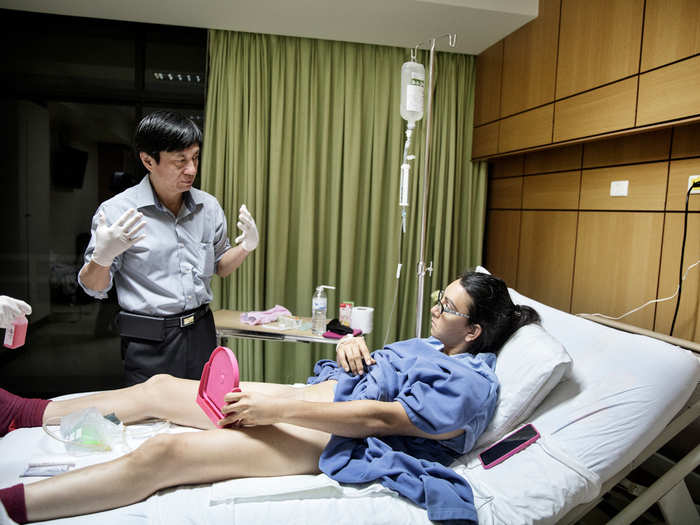
Dr Suporn Watanyusakul shows patient Olivia Thomas her new vagina after gender reassignment surgery at a hospital in Chonburi, near Bangkok, Thailand.
Thailand leads the world as a medical tourism destination, with gender-affirming surgery forming a strong niche. Treatment can be considerably cheaper than in other countries around the world, and the large numbers of patients mean that surgeons become highly experienced. The use of new technologies and procedures is also often given as a reason for Thailand’s popularity among people seeking treatment for gender dysphoria.
Contemporary Issues - Third Prize, Singles
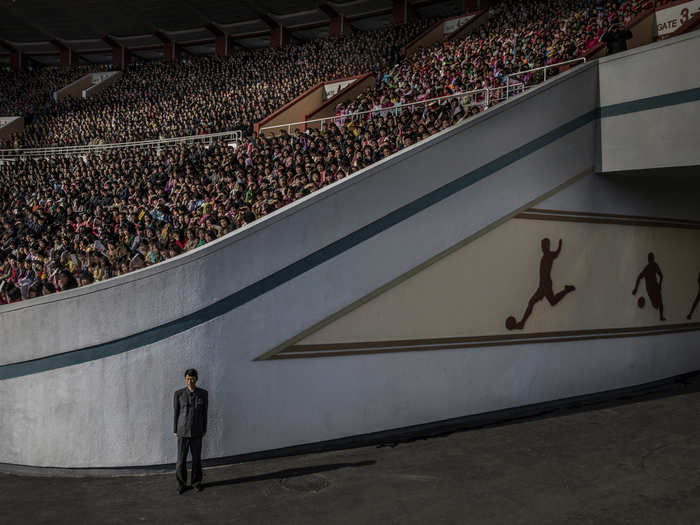
A crowd awaits the start of the Pyongyang Marathon at the Kim Il-sung Stadium, while an official guards the exit, in Pyongyang, North Korea.
More than 50,000 spectators assembled to see the start of the marathon. Thousands more gathered on the streets of the North Korean capital along a route that took runners past such landmarks as the Arch of Triumph, Kim Il-sung Square, and the Grand Theatre. North Korea is one of the most isolated and secretive nations on earth. A leadership cult has grown around the Kim dynasty, passing from Kim Il Sung (the Great Leader) to his son Kim Jong Il (the Dear Leader) and grandson, the current supreme leader Kim Jong Un. The country is run along rigidly state-controlled lines. Local media are strictly regulated, and the foreign press largely excluded, or, if allowed access closely accompanied by minders.
Contemporary Issues - First Prize, Stories
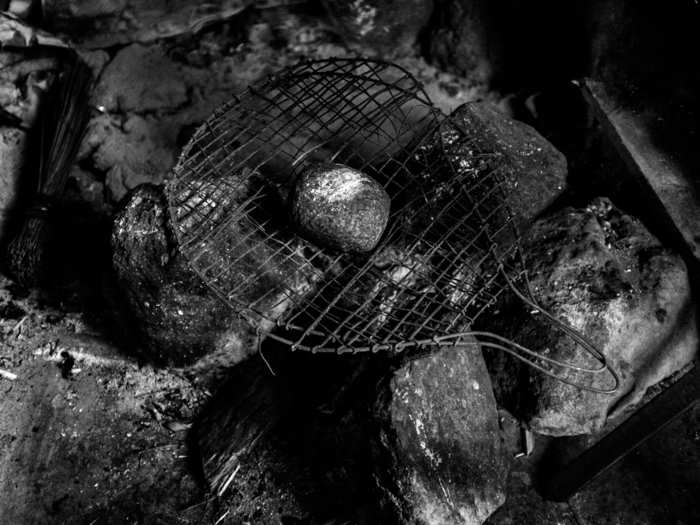
Breast ironing is a traditional practice in Cameroon that involves massaging or pressing the breasts of pubescent girls in order to suppress or reverse breast development. The practice is carried out in the belief that it will delay maturity and help prevent rapes or sexual advances. Breast ironing is usually done by the girl’s mother or an older relative. Techniques differ from region to region. Some people bind the breasts with a belt, others heat a grinding stone, spatula or pestle and use it to press or massage the breasts.
Although largely a Cameroonian practice, breast ironing does occur in some other countries across West and Central Africa. Local NGOs estimate that around 25 percent of women in the Cameroon have undergone some form of breast flattening; in some areas that rises to over 50 percent. Mothers explain that the painful procedure is an act of love, to make sure their daughters don’t get pregnant and miss out on school or jobs. There is little medical research on the psychological and physical consequences of breast flattening, but according to the United Nations Population Fund, the practice exposes girls to numerous health problems deriving from tissue damage and infection.
Contemporary Issues - Second Prize, Stories
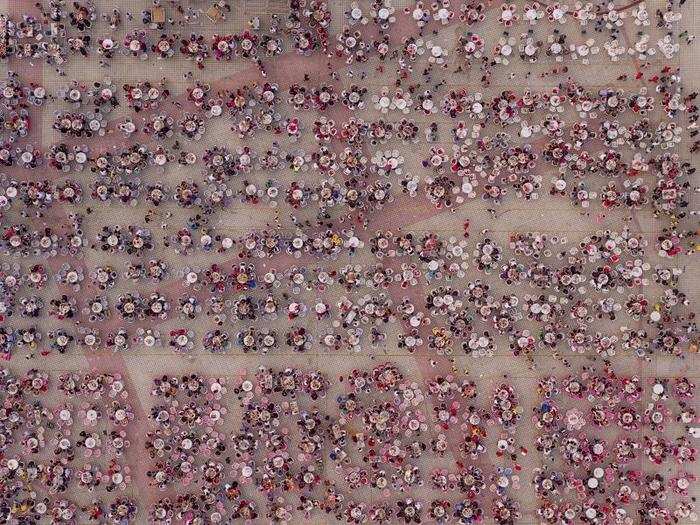
Rapidly rising incomes in China have led to a changing diet and increasing demand for meat, dairy and processed foods. China needs to make use of some 12 percent of the world’s arable land to feed nearly 19% of the global population. New technologies and agricultural reform offer a partial solution, but problems remain as farmers and the young flock to work in cities, leaving an aging rural population, and as land becomes contaminated by industry.
Contemporary Issues - Third Prize, Stories
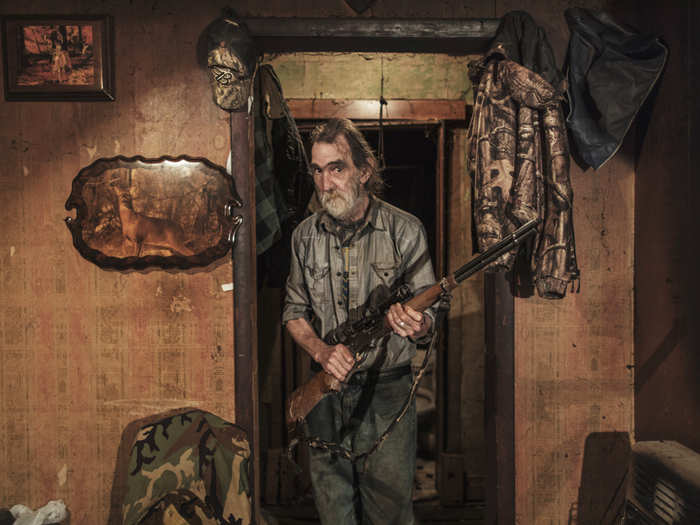
Degrees of rage in three US states: a journey made in the weeks after the Unite the Right rally in Charlottesville, Virginia. The rally was the first gathering of far-right groups from all over the country in decades, held in part to demonstrate opposition to the removal of the statue of Confederate general Robert E. Lee.
The photographer travelled through Virginia, West Virginia, and Maryland meeting a range of people, from extreme right activists to patriots and those angry at the way the US is governed, in an attempt to understand why white anger has risen to the surface.
Environment - First Prize, Singles
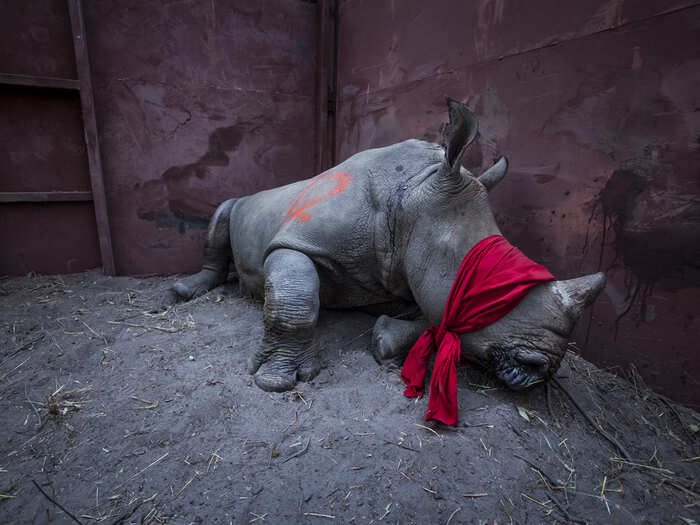
A young southern white rhinoceros, drugged and blindfolded, is about to be released into the wild in Okavango Delta, Botswana, after its relocation from South Africa for protection from poachers.
Southern white rhinos are classified as ‘near threatened.’ Rhinoceros horn is highly prized, especially in Vietnam and China, for its perceived medicinal properties, and in places is used as a recreational drug. Horns can fetch between €20,000 and €50,000 per kilogram. Poaching in South Africa rose from 13 rhinos a year in 2007 to a peak of 1,215 in 2014, and although these figures have declined slightly since then, losses are still unsustainable. Botswana is saving rhinos from poaching hotspots in South Africa and re-establishing populations in its own wildlife sanctuaries
Environment - Second Prize, Singles
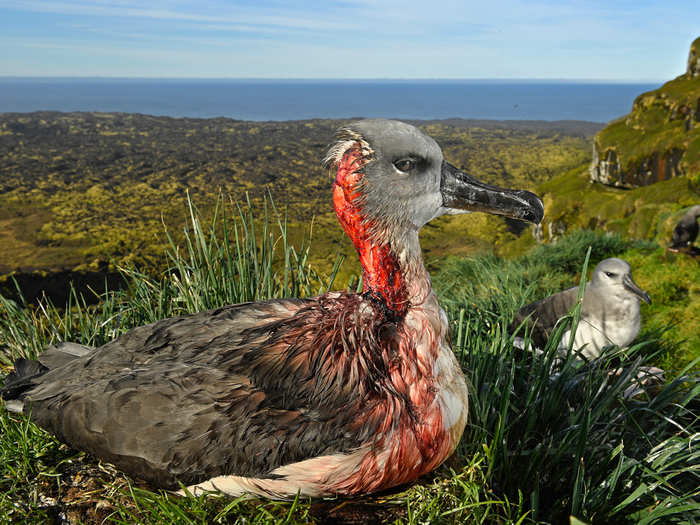
A juvenile gray-headed albatross on Marion Island, South African Antarctic Territory, is left injured after an attack by mice from an invasive species that has begun to feed on living albatross chicks and juveniles.
Mice were introduced to the island by sealers in the 1800s and co-existed with the birds for almost 200 years. In 1991, South Africa eradicated feral cats from Marion Island, but a subsequent plan to do the same to the mouse population failed to materialize. An expanding population and declining food sources led the abnormally large mice to attack albatrosses and burrowing petrels. An environmental officer has now been appointed to monitor the mouse population and conduct large-scale poison bait trials.
Environment - Third Prize, Singles
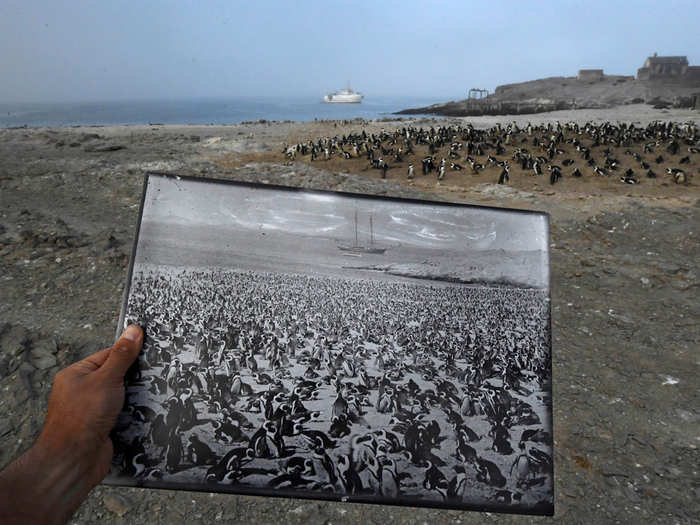
A historic photograph of an African penguin colony, taken in the late 1890s, is a stark contrast to the declining numbers seen in 2017 in the same location, on Halifax Island, Namibia. The colony once numbered more than 100,000 penguins.
The African penguin, once southern Africa’s most abundant seabird, is now listed as endangered. Overall, the African penguin population is just 2.5 percent of its level 80 years ago; research conducted on Halifax Island by the University of Cape Town indicates the population has more than halved in the past 30 years. Historically, the demand for guano (bird excrement used for fertilizer) was a cause of the decline: the birds burrow into deposits of guano to nest. Human consumption of eggs and overfishing of surrounding waters are also seen as causes. In the seas around Halifax Island sardine and anchovy — the chief prey of the African penguin — are now almost absent.
Environment - First Prize, Stories
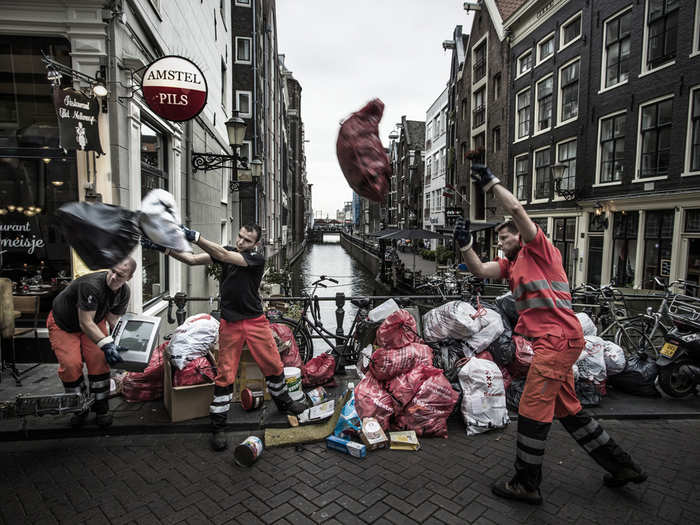
Humans are producing more waste than ever before. According to research by the World Bank, the world generates 3.5 million tonnes of solid waste a day, ten times the amount of a century ago. Rising population numbers and increasing economic prosperity fuel the growth, and as countries become richer, the composition of their waste changes to include more packaging, electronic components and broken appliances, and less organic matter. Landfills and waste dumps are filling up, and the World Economic Forum reports that by 2050 there will be so much plastic floating in the world’s oceans that it will outweigh the fish. A documentation of waste management systems in metropolises across the world investigates how different societies manage — or mismanage — their waste.
Environment - Second Prize, Stories
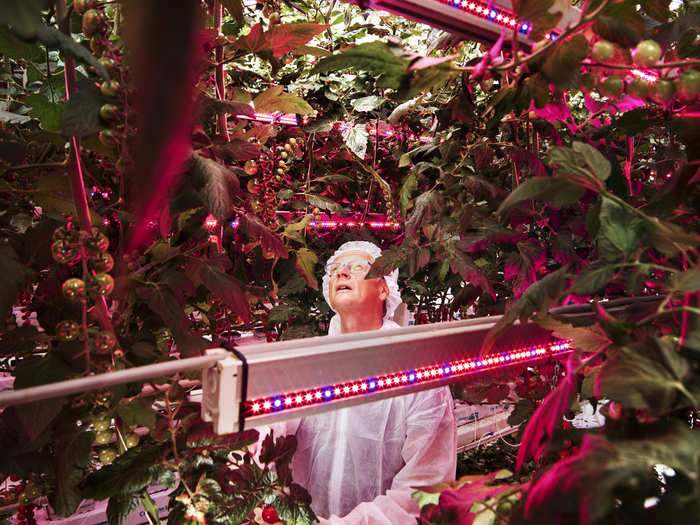
The planet must produce more food in the next four decades than all farmers in history have harvested over the past 8,000 years. Small and densely populated, the Netherlands lacks conventional sources for large-scale agriculture but, mainly through innovative agricultural practice, has become the globe’s second largest exporter of food as measured by value. It is beaten only by the USA, which has 270 times its landmass.
Since 2000, Dutch farmers have dramatically decreased dependency on water for key crops, as well as substantially cutting the use of chemical pesticides and antibiotics. Much of the research behind this takes place at Wageningen University and Research (WUR), widely regarded as the world’s top agricultural research institution. WUR is the nodal point of ‘Food Valley,’ an expansive cluster of agricultural technology startups and experimental farms that point to possible solutions to the globe’s hunger crisis.
Environment - Third Prize, Stories
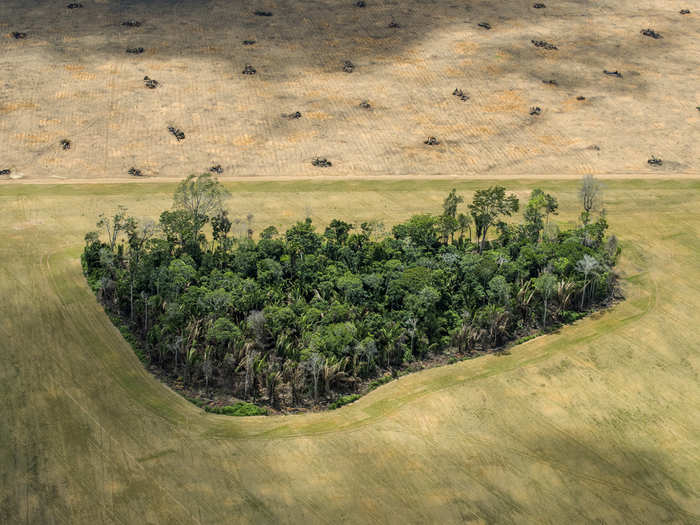
A remnant of rainforest stands in fields cleared for agriculture, near the Tapajós River, Brazilian Amazon.
After declining from major peaks in 1995 and 2004, the rate of deforestation in the Brazilian Amazon increased sharply in 2016, under pressure from logging, mining, agriculture, and hydropower developments. The Amazon forest is one of Earth’s great ‘carbon sinks’, absorbing billions of tonnes of carbon dioxide each year and acting as a climate regulator. Without it, the world’s ability to lock up carbon would be reduced, compounding the effects of global warming.
General News - First Prize, Singles
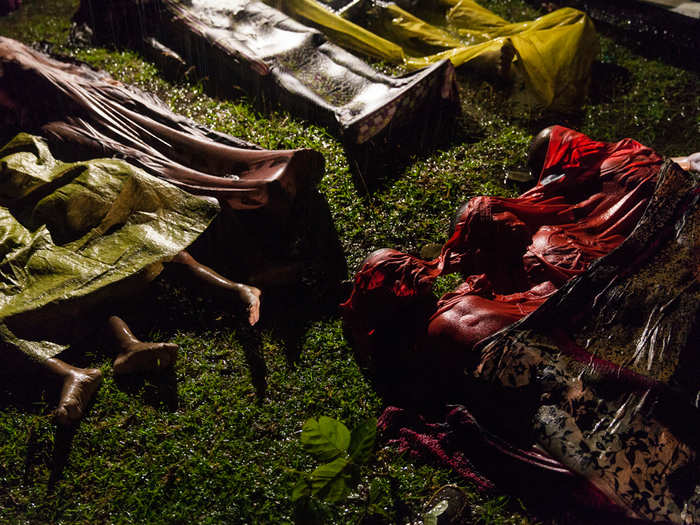
The bodies of Rohingya refugees are laid out after the boat in which they were attempting to flee Myanmar capsized about eight kilometers off Inani Beach, near Cox's Bazar, Bangladesh. Around 100 people were on the boat before it capsized. There were 17 survivors.
The Rohingya are a predominantly Muslim minority group in Rakhine State, western Myanmar. They number around 1 million people, but laws passed in the 1980s effectively deprived them of Myanmar citizenship. Violence erupted in Myanmar on 25 August after a faction of Rohingya militants attacked police posts, killing 12 members of the Myanmar security forces. Myanmar authorities, in places supported by groups of Buddhists, launched a crackdown, attacking Rohingya villages and burning houses. According to the UNHCR, the number of Rohingya that subsequently fled Myanmar for Bangladesh reached 500,000 on 28 September.
General News - Second Prize, Singles
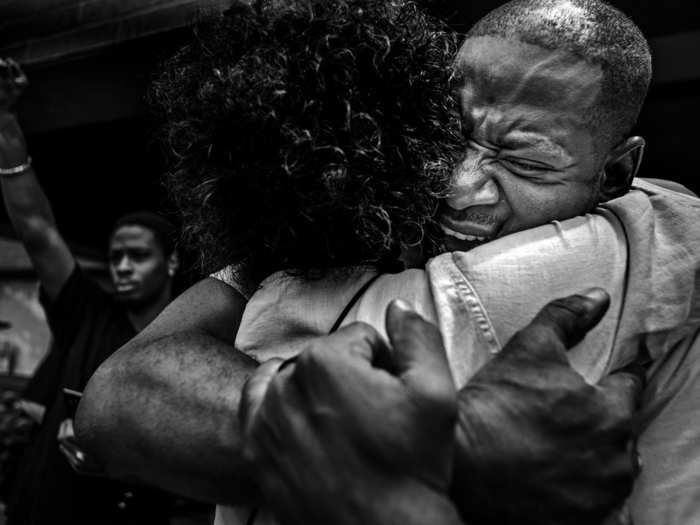
John Thompson is embraced in St Anthony Village, Minnesota, USA, after speaking out at a memorial rally for his close friend Philando Castile, two days after police officer Jeronimo Yanez was acquitted of all charges in the shooting of Castile.
In July 2016, Officer Yanez had pulled over Castile’s car in Falcon Heights Minnesota as it had a broken brake light. Castile, an African American man, handed over proof of insurance when asked, and informed the officer that he had a gun in the car. Police dashboard camera footage reveals that Yanez shouted, “Don’t pull it out,” and fired seven shots into the vehicle, fatally wounding Castile. Yanez was found not guilty of second degree manslaughter on 16 June 2017. Thompson was a high-profile presence at rallies following his friend’s death.
General News - Third Prize, Singles
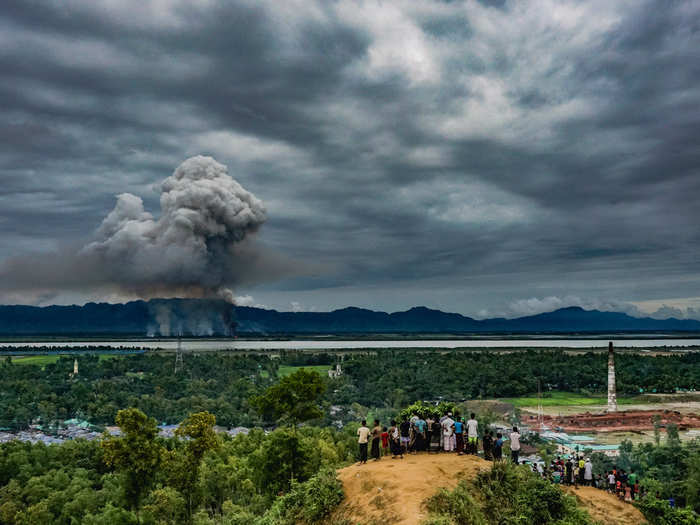
A group of Rohingya at the Leda makeshift settlement in Cox's Bazar, Bangladesh, watch as houses burn just across the border in Myanmar.
After militants of the Arakan Rohingya Salvation Army (ARSA) launched an assault on a Myanmar government police post in August, Rohingya villages were targeted and houses burned, causing an exodus of refugees to Bangladesh. The Myanmar government blamed ARSA for the village attacks. According to the refugees themselves and Human Rights Watch, which analyzed satellite imagery, Myanmar security forces set the fires. By the end of November more than 350 villages had been partially or completely destroyed.
General News - First Prize, Stories
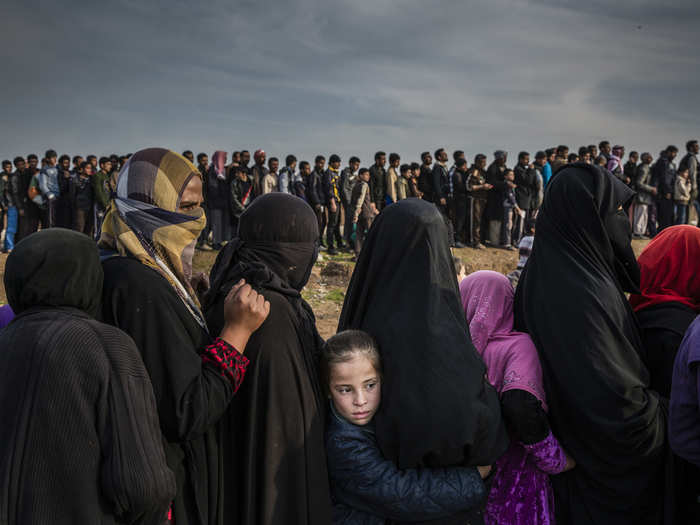
On 10 July 2017, after months of fighting, the Iraqi government declared the city of Mosul fully liberated from ISIS, although fierce fighting continued in pockets of the city. Mosul had fallen to ISIS three years earlier, and the battle to retake it had begun in October 2016.
In effect, the reconquering of Mosul comprised two parts: the battle for the eastern half of the city, and that for the west, across the Tigris River. East Mosul was recaptured by the end of January 2017, but the offensive on west Mosul, particularly the densely built-up Old City, proved more difficult. Large areas of the city were left in ruins, and huge numbers of civilians were caught in the crossfire as battle raged.
A United Nations report gives an absolute minimum of 4,194 civilian casualties during the conflict, with other sources putting the figure much higher. The Office of the UN High Commissioner for Human Rights pointed to extensive use of civilians as human shields, with ISIS fighters attempting to use the presence of civilian hostages to make certain areas immune from military operations.
After months of being trapped in the last remaining ISIS-held areas of the city, the people in west Mosul were severely short of food and water. Those who chose to remain in the city rather than go to one of the many camps for displaced people, initially relied on aid in order to survive.
General News - Second Prize, Stories
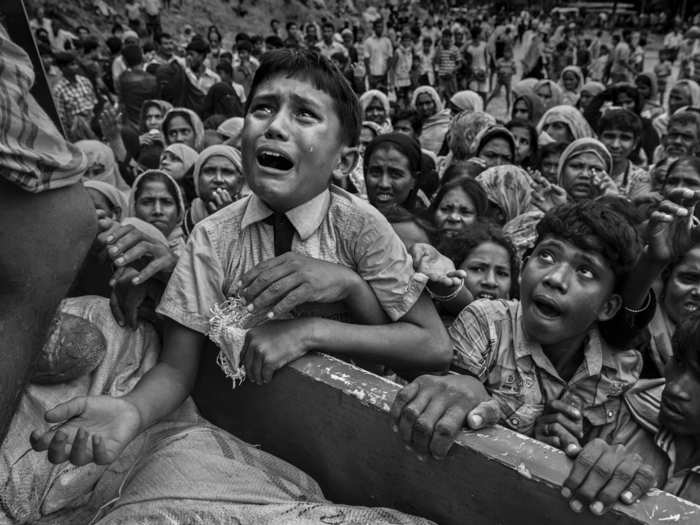
A young refugee cries as he climbs on a truck distributing aid near the Balukhali refugee camp, Cox’s Bazar, Bangladesh.
Attacks on the villages of Rohingya Muslims in Myanmar, and the burning of their homes, led to hundreds of thousands of refugees fleeing into Bangladesh on foot or by boat. Many died in the attempt. According to UNICEF, more than half of those fleeing were children. In Bangladesh, refugees were housed in existing camps and makeshift settlements. Conditions became critical; basic services came under severe pressure and, according to a Médecins Sans Frontières physician based there, most people lacked clean water, shelter and sanitation, bringing the threat of disease.
General News - Third Prize, Stories
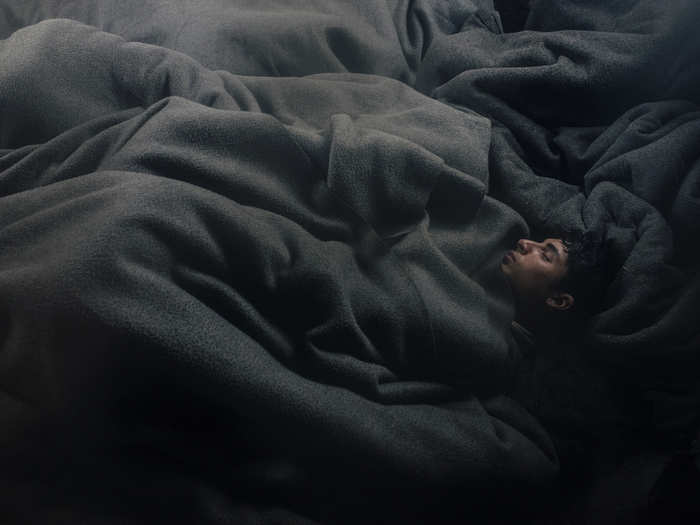
Young Afghans sleep in an abandoned train wagon in Belgrade.
The tightening of the so-called Balkan route into the European Union stranded thousands of refugees attempting to travel through Serbia to seek a new life in Europe. Many spent the freezing winter in derelict warehouses behind Belgrade's main train station. The UNHCR reported that the number of refugees in Serbia had increased from 2,000 in June 2016 to more than 7,000 by the end of the year. Some 85 percent were accommodated in government facilities, most of the others slept rough in the capital.
Long-term Projects - First Prize
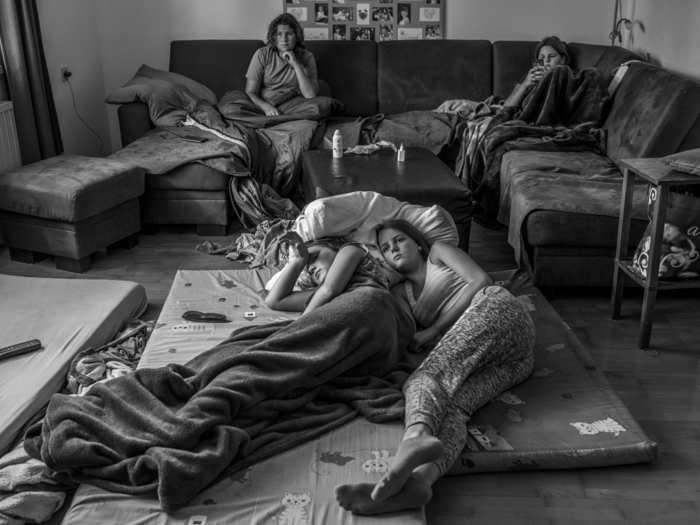
Hannah and Alena are two sisters who live in Merkenbrechts, a bioenergy village of around 170 inhabitants in Waldviertel, an isolated rural area of Austria, near the Czech border.
The girls have two older brothers, but spend much of their time together in a carefree life, swimming, playing outdoors and engrossed in games around the house. A bioenergy village is one which produces most of its own energy needs from local biomass and other renewable sources.
The photographer has been photographing Hannah and Alena since 2012. She visits them for a few weeks, usually at summertime, every year, watching them growing up and spending time together.
Long-term Projects - Second Prize
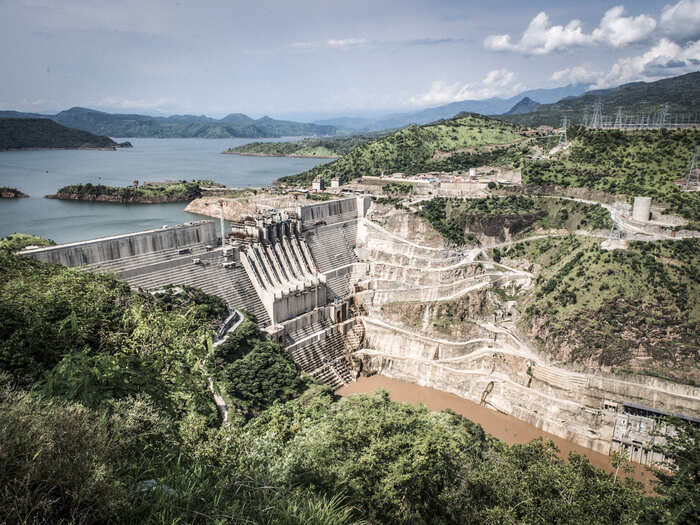
The Gibe III Dam, Omo Valley, Ethiopia.
Ethiopia is in the midst of an economic boom, with growth averaging 10.5 percent a year —double the regional average. One of the areas most impacted by this is the Omo Valley, an area of extraordinary biodiversity along the course of the Omo River, which rises in the central Shewan highlands and empties into Lake Turkana, on the border with Kenya.
Some 200,000 people of eight different ethnicities live in the Omo Valley, with another 300,000 around Lake Turkana in Kenya. Many are reliant on the river for their food security: on fish in the river and lake, and on crops and pastures grown in the fertile soil deposited by annual natural floods. Gibe III Dam — at 243 meters the tallest in Africa, and generating some 1,800 MW of hydroelectric power — was built with a dual aim: to provide energy for the booming economy and for export, and to deliver an irrigation complex for high-value agricultural development. It was also said that the dam would become a tourist attraction, of socio-economic benefit. Both Ethiopian and Kenyan governments support the dam and have disputed claims of a negative environmental impact, but critics point to such adverse effects as the cessation of natural floods, diminishing biodiversity, falling water levels in Lake Turkana, and the displacement of traditional peoples who have lived for centuries in a delicate balance with the environment.
The photographer visited the Omo Valley during the final years of the dam’s construction, with the aim of producing a meditation on how important investments can nonetheless put the human-environment balance at risk, and on how the changes brought about by the presence of such large amounts of money disrupt existing equilibrium.
Long-term Projects - Third Prize
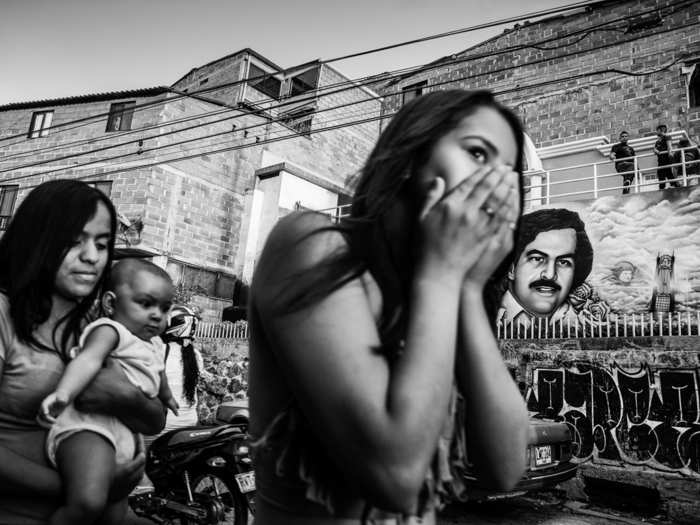
Women walk past a mural depicting drug lord turned politician Pablo Escobar, in the Barrio de la Milagrosa, Medellín, Colombia. Before his assassination in 1993, Escobar had gained popularity in some quarters of the city through his contributions to building housing in poorer neighborhoods.
After years of experiencing social chaos, drugs trafficking and political corruption, many Latin Americans are determined to resist the violence afflicting their homelands. Armed conflict and socio-economic collapse in a number of Latin American countries in the latter part of the 20th century forcibly displaced hundreds of thousands of people, both to neighboring states and northwards to the US. Stricter US policies in the mid-1990s led to the deportation of members of maras, Hispanic gangs formed on the streets of cities such as Los Angeles, and fueled gang warfare across Latin America. This, and violence associated with both the drugs trade and the so-called War on Drugs, has led to a number of Latin American cities ranking with the most violent in the world outside of a conflict zone.
This project describes the fear, anger and impotence of victims amidst the daily terror of street gangs, murder and thievery in Honduras, El Salvador, Guatemala and Colombia. The photographer wanted to document the heart of uncontrolled violence in Latin America, and the social and political factors that aggressively reinforce that violence, as well as the determination to end it.
Nature - First Prize, Singles
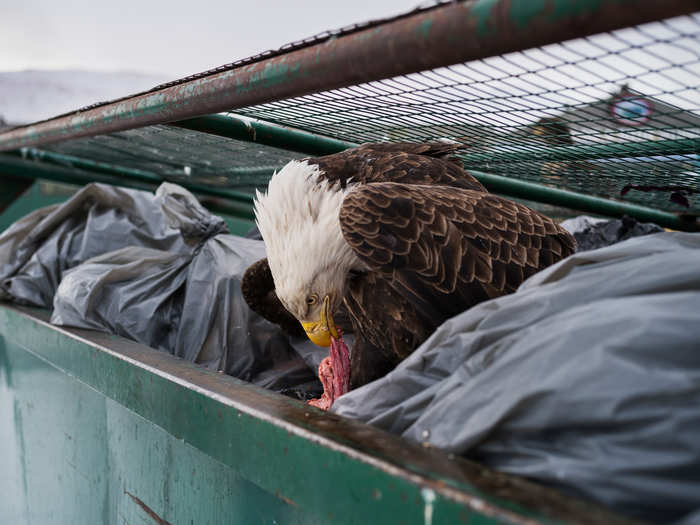
A bald eagle feasts on meat scraps in the garbage bins of a supermarket in Dutch Harbor, Alaska, US.
Once close to extinction, the bald eagle has made a massive comeback after concerted conservation efforts. Unalaska has a population of around 5,000 people, and 500 eagles. Some 350 million kilograms of fish are landed in Dutch Harbor annually. The birds are attracted by the trawlers, but also feed on garbage and snatch grocery bags from the hands of unsuspecting pedestrians. Locally, the American national bird is known as the ‘Dutch Harbor pigeon’.
Nature - Second Prize, Singles
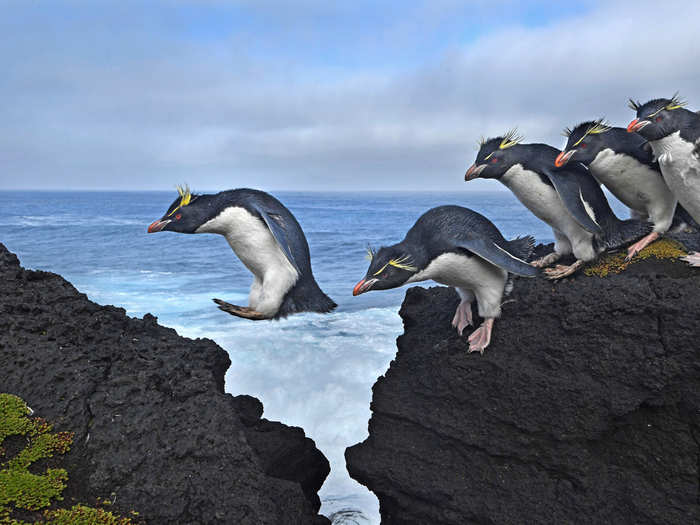
Rockhopper penguins live up to their name as they navigate the rugged coastline of Marion Island, a South African Antarctic Territory in the Indian Ocean.
Among the most numerous of penguins, rockhoppers are nevertheless considered vulnerable, and their population is declining, probably as the result of a decreasing food supply. The birds spend five to six months at sea, coming to shore only to molt and breed. They are often found bounding, rather than waddling as other penguins do, and are capable of diving to depths of up to 100 meters in pursuit of fish, crustaceans, squid, and krill.
Nature - Third Prize, Singles
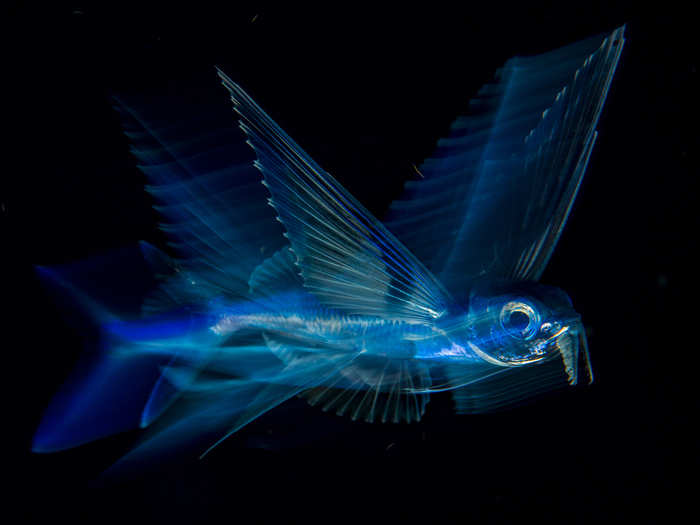
A flying fish swims below the surface in the Gulf Stream late at night, offshore from Palm Beach, Florida, US.
Moving its tail fin up to 70 times per second, a flying fish can reach an underwater speed of nearly 60 kilometers per hour. Angling itself upwards, it then breaks the surface while still propelling itself along by rapidly beating its tail underwater, before taking to the air and gliding — successfully escaping predators such as tuna, marlin and swordfish.
Nature First Prize - Stories
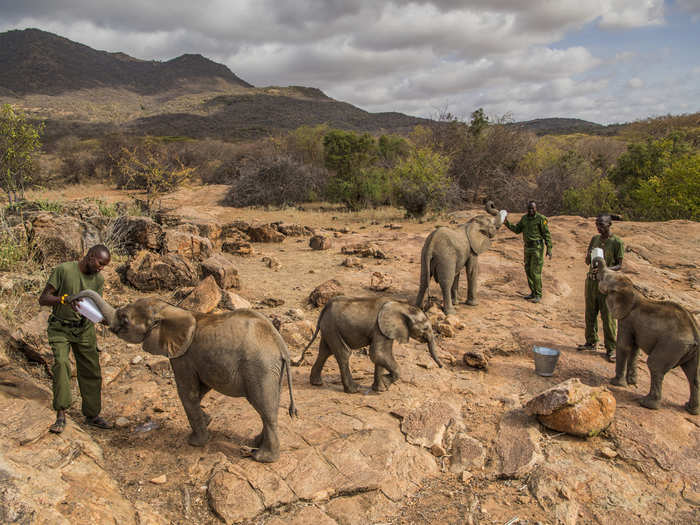
Keepers feed baby elephants at the Reteti Elephant Sanctuary in northern Kenya.
Orphaned and abandoned elephant calves are rehabilitated and returned to the wild, at the community-owned Reteti Elephant Sanctuary in northern Kenya. The Reteti sanctuary is part of the Namunyak Wildlife Conservation Trust, located in the ancestral homeland of the Samburu people. The elephant orphanage was established in 2016 by local Samburus, and all the men working there are, or were at some time, Samburu warriors. In the past, local people weren’t much interested in saving elephants, which can be a threat to humans and their property, but now they are beginning to relate to the animals in a new way. Elephants feed on low brush and knock down small trees, promoting the growth of grasses — of advantage to the pastoralist Samburu.
Nature - Second Prize, Stories
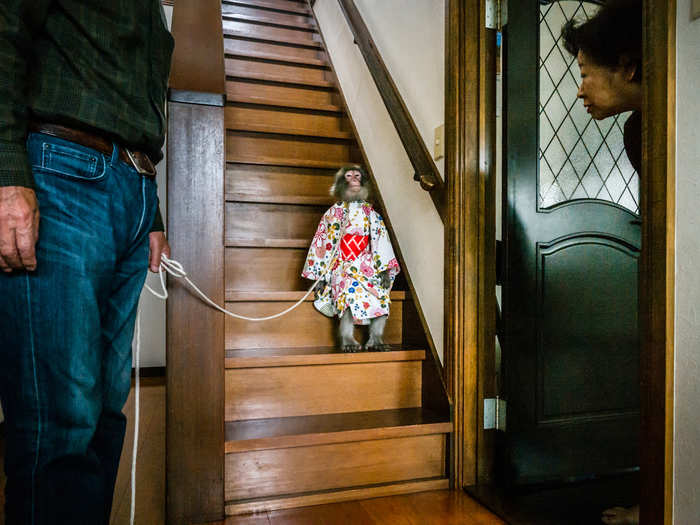
Mr Amakaki gets ready to babysit Sakura, a macaque owned by his neighbor Kaoru Amagai, in Ōta-shi, Gunma, central Japan.
In recent years, the Japanese macaque, best known as the snow monkey, has become habituated to humans. As the range of the macaque habitat expands from mountain areas to sub-alpine and lowland regions, the animals have lost their fear, have taken to raiding crops, and are often seen as pests. Despite macaques being officially protected in Japan since 1947, some local laws allow them to be tamed and trained for the entertainment industry. Once considered sacred mediators between gods and humans, monkeys in Japan also came to be seen as representing dislikable humans, deserving of ridicule. Commercial entertainment involving monkeys has existed in Japan for over 1,000 years.
Nature - Third Prize, Stories
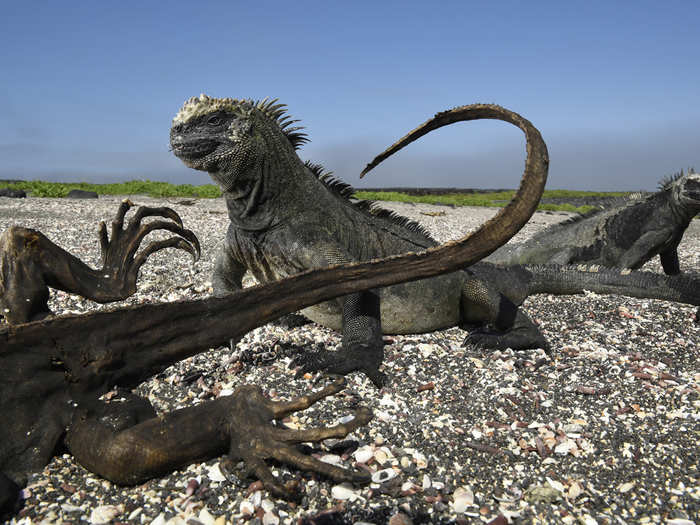
Marine iguanas, the icons of the Galapagos, feed on marine algae and seaweeds, some of which die rapidly when the ocean warms. El Niño causes iguanas’ green food algae to disappear, and the lizards do not eat the invasive brown algae that replaces it.
Four major ocean currents converge along the Galapagos archipelago, creating the conditions for an extraordinary diversity of animal life. The islands are home to at least 7,000 flora and fauna species, of which 97 percent of the reptiles, 80 percent of the land birds, 50 percent of the insects and 30 percent of the plants are endemic. The local ecosystem is highly sensitive to the changes in temperature, rainfall and ocean currents that characterize the climatic events known as El Niño and La Niña. These changes cause marked fluctuations in weather and food availability. Many scientists expect the frequency of El Niño and La Niña to increase as a result of climate change, making the Galapagos a possible early-warning location for its effects
People - First Prize, Singles
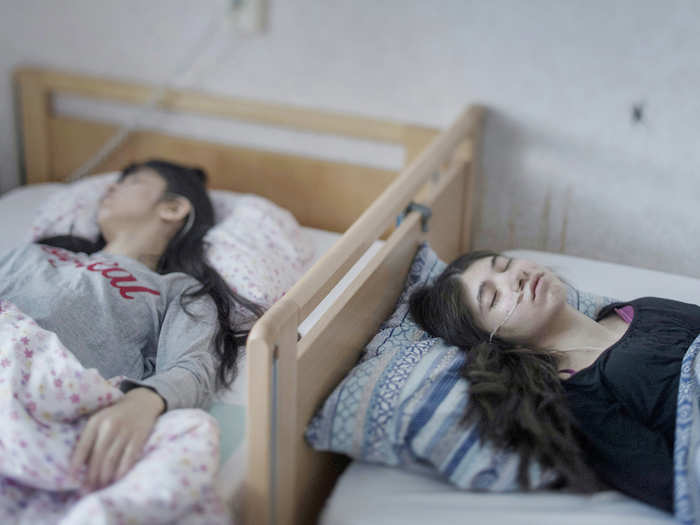
Djeneta has been bedridden and unresponsive for two-and-a-half years, and her sister Ibadeta for more than six months, with uppgivenhetssyndrom (resignation syndrome), in Horndal, Sweden.
Djeneta and Ibadeta are Roma refugees, from Kosovo. Resignation syndrome (RS) renders patients passive, immobile, mute, unable to eat and drink, incontinent and unresponsive to physical stimulus. It is a condition believed to exist only amongst refugees in Sweden. The causes are unclear, but most professionals agree that trauma is a primary contributor, alongside a reaction to stress and depression. It is also not clear why cases are found exclusively in Sweden. RS has so far affected only refugees aged seven to 19, and mainly those from ex-Soviet countries or the former Yugoslavia. For many, the syndrome is triggered by having a residence application rejected. Granting residence to families of sufferers is often cited as a cure.
People - Second Prize, Singles
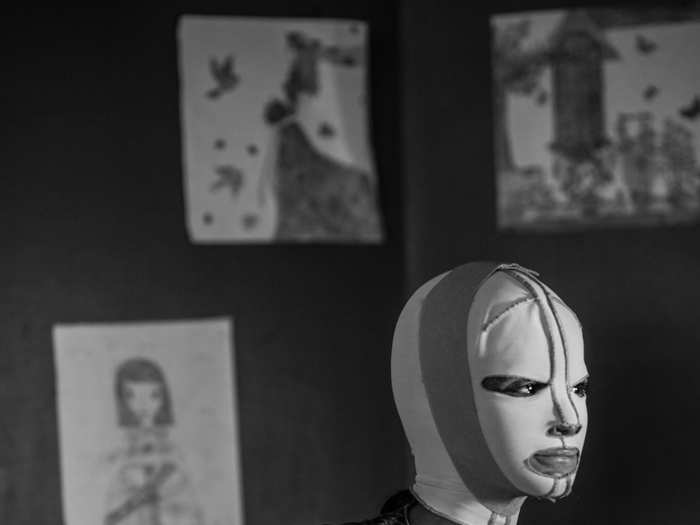
Manal (11), a victim of a missile explosion in Kirkuk, Iraq, wears a mask for several hours a day to protect her face, following extensive plastic surgery at the Médecins Sans Frontières Reconstructive Surgery Program, Al-Mowasah Hospital, Amman, Jordan.
Children and adults from Yemen, Iraq, Syria, and Gaza who have been badly injured by bombs, car explosions or other accidents live in the hospital with a relative or friend.
Manal, who was displaced along with her mother and two brothers, endured severe burns to her face and arms. She had no surgery before coming to Jordan and had difficulty in closing her right eye. After many plastic surgery operations, she now wears her mask for several hours a day, primarily to protect her skin from the light. Manal has many friends at the hospital, and loves drawing and telling stories, as well as the many organized activities for children.
People - Third Prize, Singles
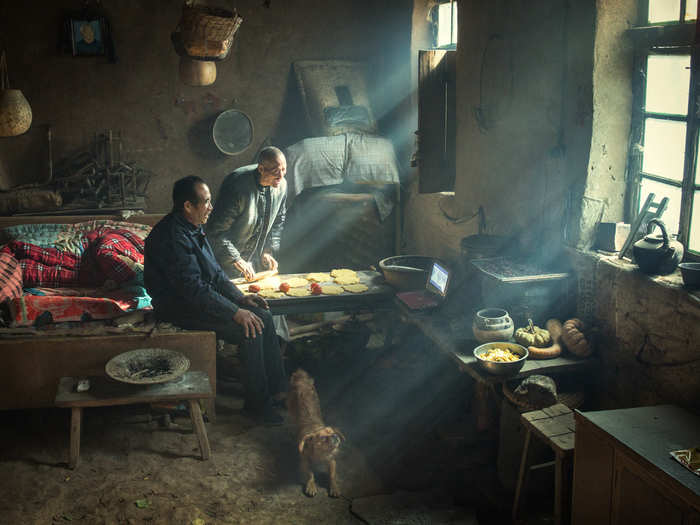
Two brothers live in a traditional yaodong (‘kiln cave’), carved into a hillside on the Loess Plateau in central China. The earth-lined walls have good insulating properties, enabling residents to survive cold winters.
The yaodong is one of the earliest housing types in China, dating back more than 2,000 years. The Loess Plateau in the upper and middle reaches of the Yellow River, is approximately the size of France.The loess soil — fine, mineral-rich, wind-blown silt, accumulated over centuries — is hundreds of meters thick in some places, and the numbers of yaodong run into millions. The loess not only keeps the dwellings warm in winter, but also cool in summer. The brothers, who are both unmarried, have lived in this yaodong for most of their lives.
People - First Prize, Stories
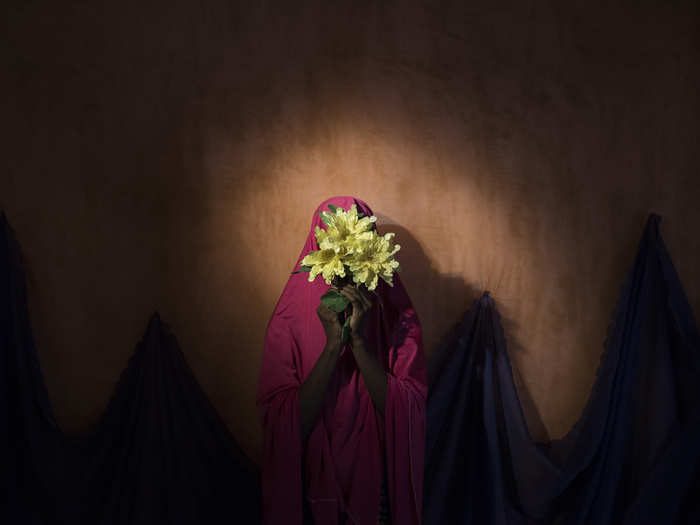
Portraits of girls kidnapped by Boko Haram militants, taken in Maiduguri, Borno State, Nigeria.
The girls were strapped with explosives, and ordered to blow themselves up in crowded areas, but managed to escape and find help instead of detonating the bombs. Boko Haram — a Nigeria-based militant Islamist group whose name translates roughly to ‘Western education is forbidden’ — expressly targets schools and has abducted more than 2,000 women and girls since 2014. Female suicide bombers are seen by the militants as a new weapon of war. In 2016, The New York Times reported at least one in every five suicide bombers deployed by Boko Haram over the previous two years had been a child, usually a girl. The group used 27 children in suicide attacks in the first quarter of 2017, compared to nine during the same period the previous year.
People - Second Prize, Stories
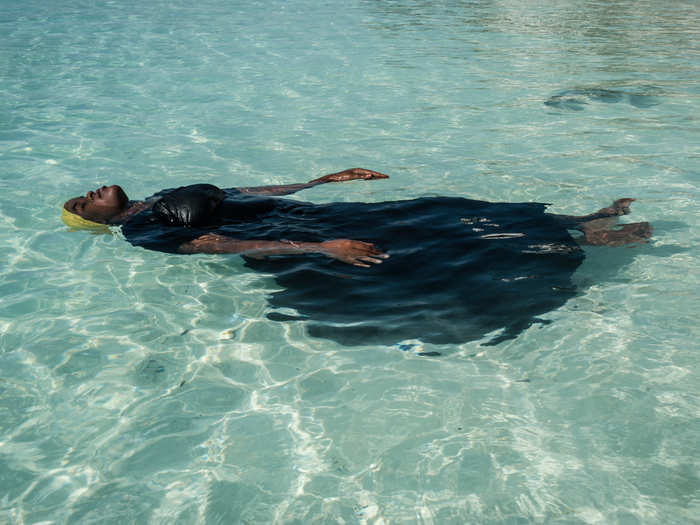
A young woman learns to float, in the Indian Ocean, off Nungwi, Zanzibar.
Traditionally, girls in the Zanzibar Archipelago are discouraged from learning how to swim, largely because of the strictures of a conservative Islamic culture and the absence of modest swimwear. But in villages on the northern tip of Zanzibar, the Panje Project (panje translates as ‘big fish’) is providing opportunities for local women and girls to learn swimming skills in full-length swimsuits, so that they can enter the water without compromising their cultural or religious beliefs.
People - Third Prize, Stories
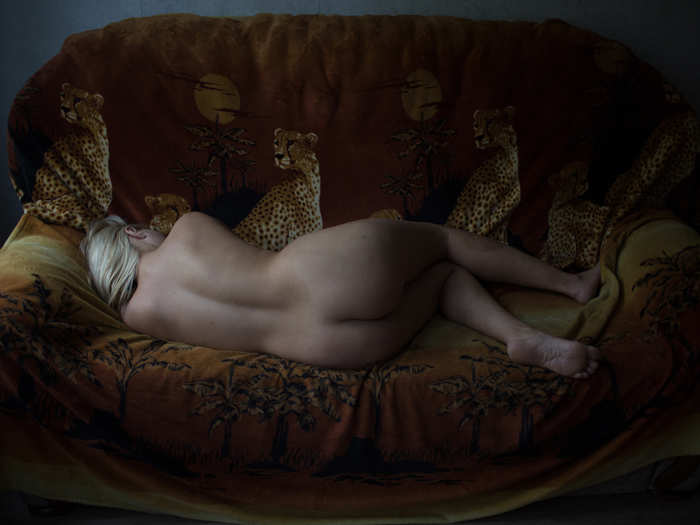
Alena (33) was born in Ukraine and raised in an orphanage. She moved from Donetsk to St Petersburg after the war in Ukraine, thinking that she was being offered work as an administrator in a brothel, only to find that the job was as a sex worker.
Official statistics say that there are 1 million sex workers in Russia. Silver Rose, a St Petersburg NGO, puts that at closer to 3 million, with more than 50,000 women working in St Petersburg alone. Prostitution is illegal in Russia, and though fines are not large (about €28) women are vulnerable to extortion because they fear the consequences of having a criminal record.
According to Silver Rose, despite the stereotypical view of sex workers, only a small percentage have taken to prostitution because they are addicts or living in extreme poverty. The decline of the Russian economy has led to a growing number of women — many over the age of 35 — who have lost jobs in such fields as business or education becoming sex workers.
Sports - First Prize, Singles
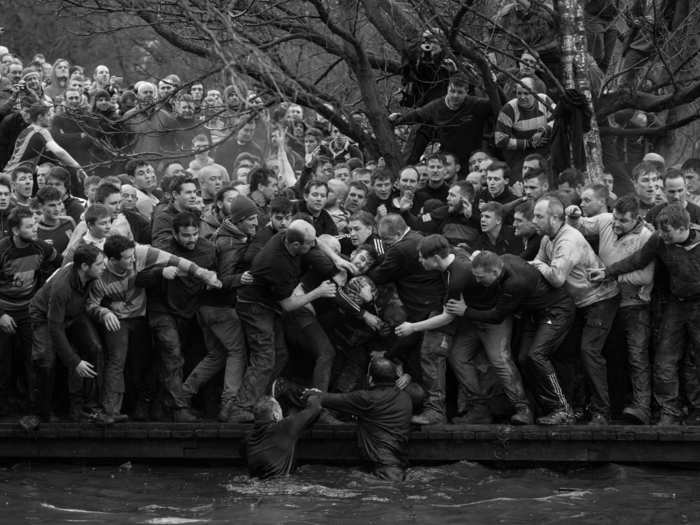
Members of opposing teams, the Up’ards and Down’ards, grapple for the ball during the historic, annual Royal Shrovetide Football Match in Ashbourne, Derbyshire, UK.
The game is played between hundreds of participants in two eight-hour periods on Shrove Tuesday and Ash Wednesday (the day preceding and the day marking the start of Christian Lent). The two teams are determined by which side of the River Henmore players are born: Up’ards are from north of the river; Down’ards, south. Players score goals by tapping the ball three times on millstones set into pillars three miles apart.
There are very few rules apart from an historic stipulation that players may not murder their opponents, and the more contemporary requirement that the ball must not be transported in bags, rucksacks, or motorized vehicles. Royal Shrovetide Football is believed to have been played in Ashbourne since the 17th century.
Sports - Second Prize, Singles
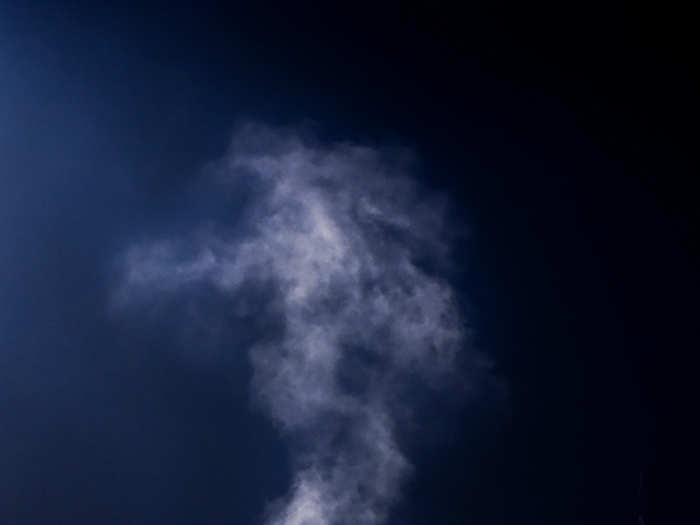
The British & Irish Lions and Maori All Blacks engage during a match at Rotorua International Stadium in Rotorua, New Zealand.
All players in the Maori All Blacks must have a confirmed Maori whakapapa, or genealogy. The British & Irish Lions is a composite squad formed every year by players from England, Scotland, Wales, and Ireland, selected by the coach who oversees the tour. The squad tours annually through one of the southern hemisphere’s big three rugby union nations: Australia, New Zealand, and South Africa. The Rotorua match was played in wet conditions and ended with a 10-32 win for the Lions.
Sports - Third Prize, Singles
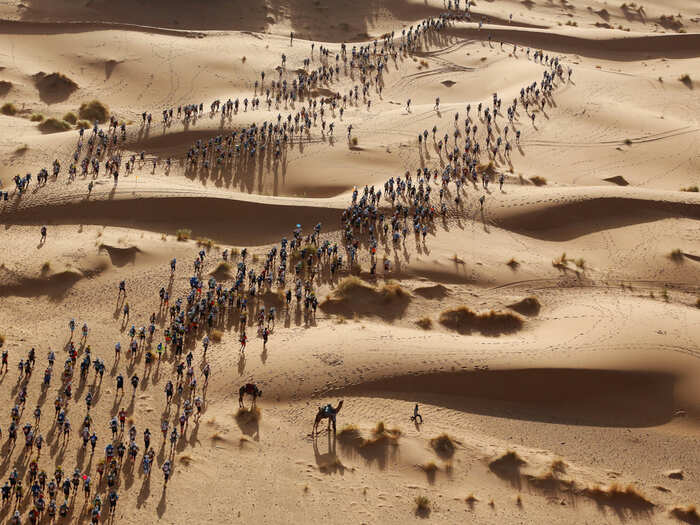
Participants set off on a timed stage of the Marathon des Sables, in the Sahara Desert in southern Morocco.
The Marathon des Sables (Marathon of the Sands) is run over 250 kilometers in temperatures of up to 50℃. Participating runners and walkers must carry their own backpacks with food, sleeping gear, and other material. The marathon is conducted in six stages, over seven days, with one long stage of more than 80 kilometers. The first Marathon des Sables was held in 1986 with 186 competitors. The event now attracts more than 1,000 participants from around 50 countries.
Sports - First Prize, Stories
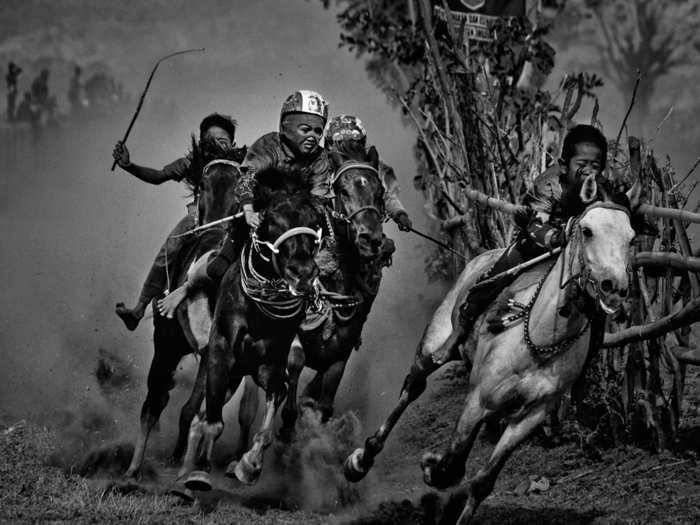
Young jockeys compete in a Maen Jaran horse race, on Sumbawa Island, Indonesia.
Child jockeys ride bareback, barefoot, and with little protective gear, on small horses, during Maen Jaran horse races, on Sumbawa Island, Indonesia. Maen Jaran is a tradition passed on from generation to generation. Once a pastime to celebrate a good harvest, horse racing was transformed into a spectator sport on Sumbawa by the Dutch in the 20th century, to entertain officials. The boys, aged between five and ten, mount their small steeds five to six times a day, reaching speeds of up to 80 kilometers per hour. Winners receive cash prizes, and participants earn €3.50 ($4.30) to €7 ($8.60) per mount.
Sports - Second Prize, Stories
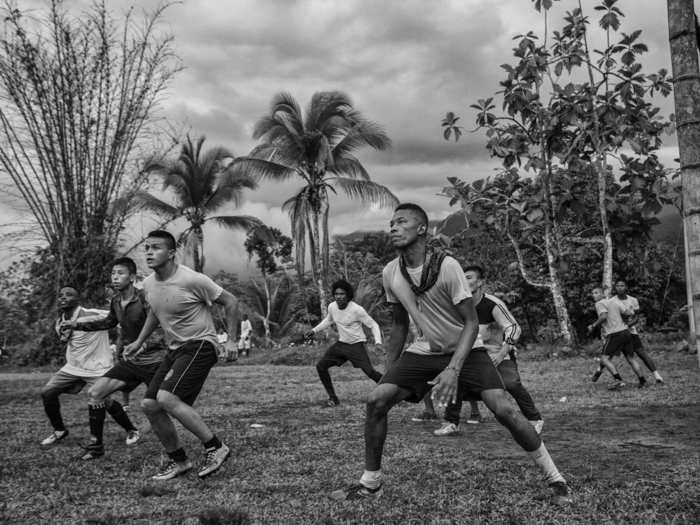
Members of the Colombian army play a friendly match with a FARC team in Vegaez, Antioquia, Colombia.
Guerrillas of the Revolutionary Armed Forces of Colombia (FARC), having laid down weapons after more than 50 years of conflict, have moved from jungle camps to ‘transitional zones’ across the country, to demobilize and begin the return to civilian life. Many are taking part in football matches with teams made up of members of the Colombian military, as well as victims of the conflict. The plan is for the best players from transitional-zone teams to form La Paz FC (Peace FC) football team.
Sports - Third Prize, Stories
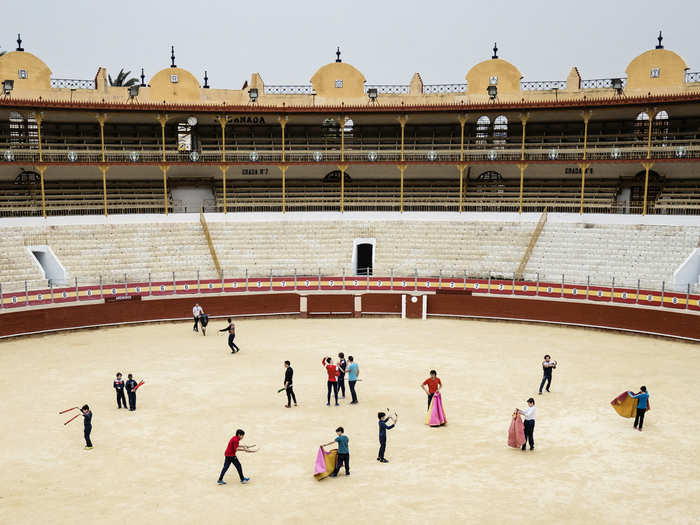
A new generation of bullfighters practice at the bullring in Almería, Spain.
Bullfighting has long generated controversy and is declining in popularity, even in Spain, yet across the country boys still dream of stardom in the arena, and attend bullfighting schools to learn the requisite skills. At the Escuela Taurina Almería, a bullfighting school in Almería, Spain, boys aged 10 to 16 practice three times a week. The minimum age that boys may participate in a proper corrida, with a live bull, is 16. In February 2018, the UN Committee on the Rights of the Child urged Spain to ban children from attending bull fights or bullfighting schools. Proponents say that bullfighting is part of Spain’s national fabric, an art form that encourages striving for the best.
Spot News - Second Prize, Singles

People are thrown into the air as a car plows into a group of protesters demonstrating against a Unite the Right rally in Charlottesville in Virginia, US.
The white nationalist rally, opposing city plans to remove a statue of Confederate icon General Robert E. Lee, attracted counter-protests. James Alex Fields Jr drove his car at high speed into a sedan, propelling it and a minivan into a group of anti-racist protesters, killing Heather Heyer (32) and injuring a further 19 people. Fields fled the scene in his own vehicle, but was stopped by Charlottesville police and later charged with murder.
Spot News - Third Prize, Singles
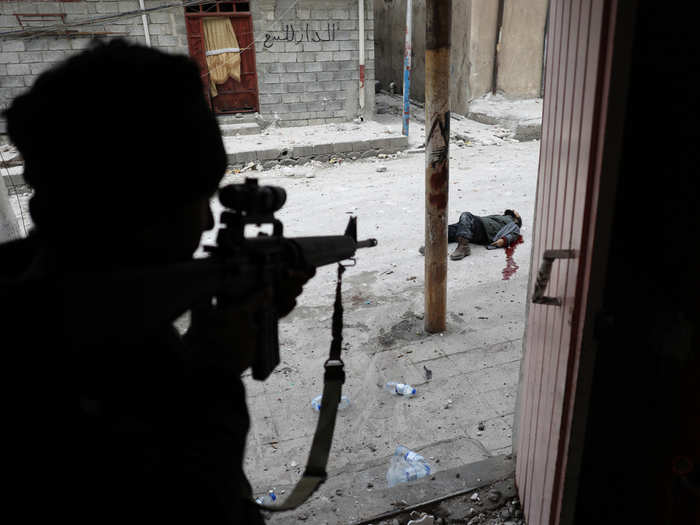
An Iraqi Special Forces soldier some moments after shooting dead a suspected suicide bomber, during the offensive to retake Mosul.
The battle to reclaim Mosul from ISIS began in October 2016 and lasted until July 2017, with fighting against pockets of ISIS militants continuing in some quarters of the city even beyond that date. The use of suicide bombers was a common tactic by the militants.
Spot News - First Prize, Stories
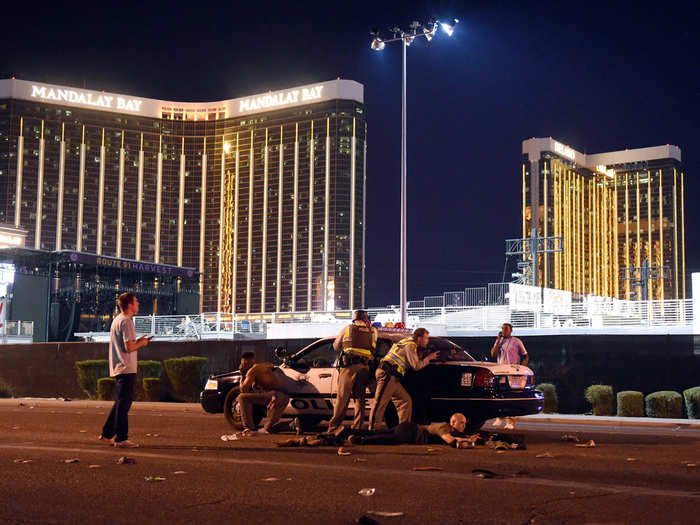
Police outside the concert grounds after a gunman opened fire on concertgoers at the Route 91 country music festival in Las Vegas, US.
Fifty-eight people were killed and more than 500 wounded when gunman Stephen Paddock opened fire on a crowd of around 22,000 concertgoers at the Route 91 Harvest Country Music Festival at the Mandalay Bay Resort and Casino in Las Vegas, Nevada, USA. Paddock fired for ten minutes from a suite on the 32nd floor of the hotel. Paddock killed himself in his hotel room after the shooting. Twenty-three guns were found in his room, some of which had been specially adapted to mimic fully automatic weapons, firing 400 to 800 rounds per minute. Paddock had no criminal record, and no motive was established for the massacre.
Spot News - Second Prize, Stories
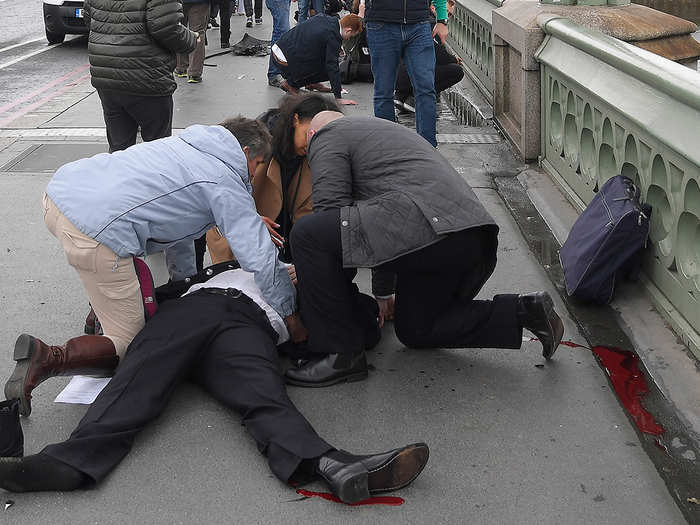
Passersby tend to an injured man lying on the sidewalk after an attack on pedestrians at Westminster Bridge in London, UK.
On 22 March, Khalid Masood drove a rented SUV along the sidewalk of Westminster Bridge, near the British Houses of Parliament in central London. Three people were killed instantly, and two more died in the days after the attack; at least 40 were injured. Armed with two knives, Masood left the car and attempted to enter the grounds of parliament, where he fatally stabbed one of the policemen who tried to stop him, before being shot and killed. Born Adrian Russell Elms in Kent, UK, Masood changed his name when he converted to Islam. Although ISIS claimed responsibility for the attack the following day, police investigating found no evidence of any links between Masood and either ISIS or al-Qaeda.
Spot News - Third Prize, Stories
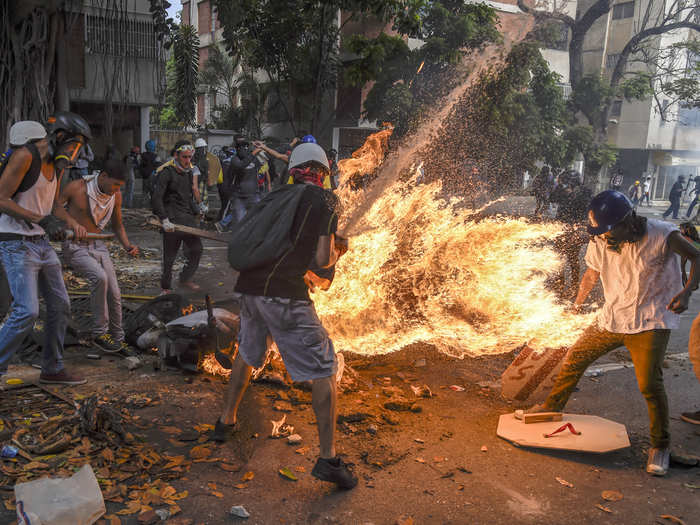
José Víctor Salazar Balza (28) caught fire after the gas tank on a motorcycle exploded, during a protest against the Venezuelan president, Nicolás Maduro, in Caracas.
Violent clashes had broken out between demonstrators and the national guard. The motorcycle, belonging to a member of the national guard, was apparently being destroyed by protesters. Accounts of the incident differ, but some say that an object thrown by protesters caused the gas tank to explode. Further reports maintain that Salazar’s clothing caught fire so readily because he was doused in petrol either by a bomb he was carrying, or that of a fellow protester. Salazar suffered severe burns to more than 70% of his body, but survived the incident.
Popular Right Now
Popular Keywords
Advertisement